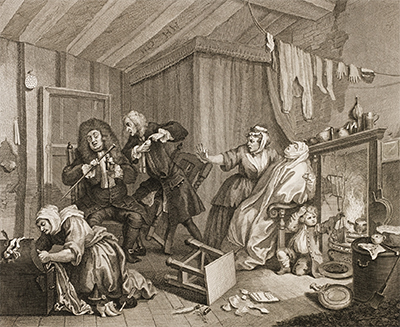Moll Dying of Syphilis painting is one of William’s earliest works titled A Harlot's Progress. The series comprised a collection of six paintings, which depicted the fate of an innocent country girl who arrives in the city in the hope of finding a better life.
Unfortunately, she falls in the hands of an old brothel keeper who suggests a profitable occupation in the town but procures her to a gentleman displayed in the first plate of this collection. Moll Dying of Syphilis painting showcases the fifth plate of William’s collection and depicts a rather sad story for the beautiful Molly who has contracted the deadly venereal disease.
Moll has just returned from prison and is dying of the illness denoted by the shroud-like blankets, wrapping her body. The servant turns to the two doctors (Dr Jean on the right and Dr Richard Rock on the left) arguing over the efficacy of their medical methods instead of attending to the distressed patient. Another woman believed to be the landlady is shown scuffling over Moll’s possessions. Moll's maid tries to stop the arguing and the looting. William introduces Moll’s son as an innocent victim of circumstances oblivious of what is happening around him.
William trained as an engraver, and most of his works, including Moll Dying of Syphilis painting are reminiscent of this era. He also uses Rococo style, which he had also learnt to apply when he was training to be an engraver. The technique allowed artists to use loose strokes to create detailed pieces even where the subjects are crowded. He also presses the brush lightly on the canvas to fine-tune details like frills and ruffles where appropriate. William’s ability to sketch objects and people from a young age also helped bring out the moral of the painting so clearly.
The theme of this period focused on the moral decay of the 18th-century society and Hogarth created this series (A Harlot’s Progress) to depict this reality. He used moral codes, which resonated with the culture at the time. For example, Hogarth includes a Passover cake in the painting, which is used as a fly-trap to imply that Moll is paying for her sins and she will not be spared from death. Moll Dying of Syphilis painting was one of the six pictures created in the 1730s. Other works produced during this period include A Midnight Modern Conversation, The Sleeping Congregation and the Southwark Fair, among others.




